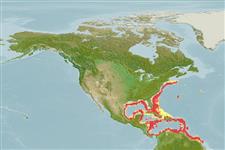Environment: milieu / climate zone / depth range / distribution range
Ecologia
marinhas batidemersal; não migratória; intervalo de profundidade 80 - 1170 m (Ref. 1371), usually 160 - 640 m (Ref. 1371). Deep-water; 42°N - 4°N, 98°W - 50°W (Ref. 58452)
Western Central Atlantic: Georges Bank, New England to Suriname and French Guiana.
Comprimento de primeira maturação / Tamanho / Peso / Idade
Maturity: Lm 28.0 range ? - ? cm
Max length : 40.6 cm TL macho/indeterminado; (Ref. 1371); 70.0 cm TL (female); common length : 30.0 cm TL macho/indeterminado; (Ref. 1371); common length :45 cm TL (female); peso máx. publicado: 0.00 g
Espinhos dorsais (total): 1; Raios dorsais (total): 45-51; Espinhos anais 0; Raios anais : 35 - 41; Vértebras: 51 - 53. Head rather long; mouth large; gill rakers short and thick, with blunt tips; pectoral fin tips reaching a vertical through anus in small fish but not in larger ones; overall color silvery white (Ref. 1371).
Offshore species which inhabit the outer part of the continental shelf and upper part of the slope. Feed at night when they come up towards the surface (Ref. 1371). Juveniles feed primarily on crustaceans (Ref. 58452). Adults' food consists primarily of fishes (particularly lantern fishes, sardines and anchovies) and, to a lesser extent, crustaceans and squids (Ref. 1371). Spawning occurs near the bottom at 330-550 m depth range from April to July in New England and from late spring to early autumn in the Gulf of Mexico and the Carribean Sea (Ref. 58452). Marketed fresh, frozen and smoked.
Cohen, D.M., T. Inada, T. Iwamoto and N. Scialabba, 1990. FAO species catalogue. Vol. 10. Gadiform fishes of the world (Order Gadiformes). An annotated and illustrated catalogue of cods, hakes, grenadiers and other gadiform fishes known to date. FAO Fish. Synop. 125(10). Rome: FAO. 442 p. (Ref. 1371)
Status na Lista Vermelha da UICN (Ref. 130435)
Ameaça para os humanos
Harmless
Uso pelos humanos
Pescarias: pouco comercial
Ferramentas
Relatórios especiais
Baixar XML
Fontes da internet
Estimates based on models
Preferred temperature (Ref.
123201): 7.1 - 20.5, mean 12.6 °C (based on 182 cells).
Índice de diversidade filogenética (Ref.
82804): PD
50 = 0.5000 [Uniqueness, from 0.5 = low to 2.0 = high].
Bayesian length-weight: a=0.00759 (0.00453 - 0.01269), b=3.01 (2.86 - 3.16), in cm total length, based on LWR estimates for this species & (Sub)family-body (Ref.
93245).
Nível Trófico (Ref.
69278): 3.4 ±0.0 se; based on diet studies.
Generation time: 2.3 ( na - na) years. Estimated as median ln(3)/K based on 2
growth studies.
Resiliência (Ref.
120179): médio(a), tempo mínimo de duplicação da população 1,4 - 4,4 anos (Assuming tmax > 3 and tm >=2; K=0.57; Fec=340,000).
Fishing Vulnerability (Ref.
59153): Low to moderate vulnerability (30 of 100).
Climate Vulnerability (Ref.
125649): Low to moderate vulnerability (29 of 100).
Nutrients (Ref.
124155): Calcium = 16.3 [7.2, 65.7] mg/100g; Iron = 0.484 [0.080, 1.352] mg/100g; Protein = 17.2 [15.7, 18.6] %; Omega3 = 0.252 [0.112, 0.506] g/100g; Selenium = 24.9 [9.8, 55.4] μg/100g; VitaminA = 11 [2, 52] μg/100g; Zinc = 0.301 [0.197, 0.490] mg/100g (wet weight);
